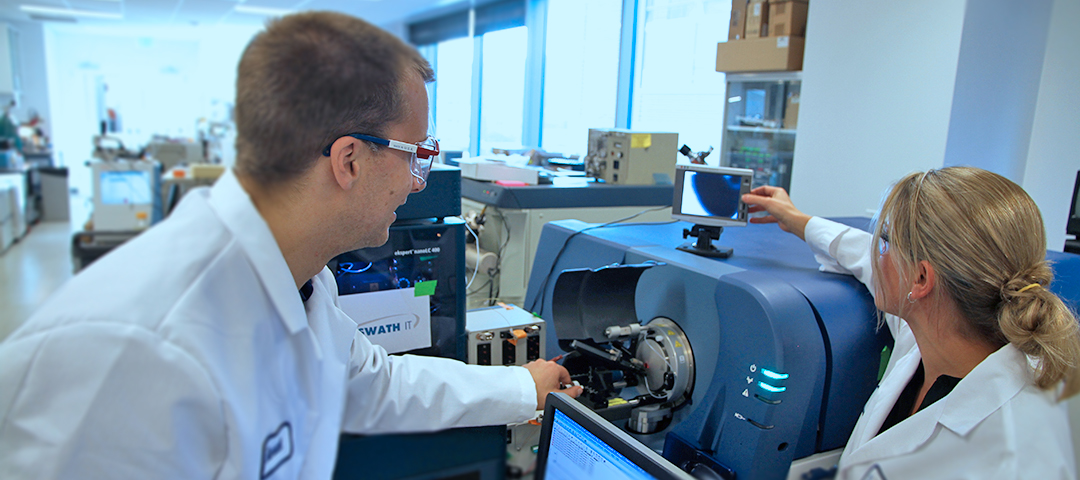ISB releases open-source software to analyze digital fingerprint of protein data
 isbscience.org/news/2015/03/20/isb-releases-open-source-software-to-analyze-digital-fingerprint-of-protein-data/
isbscience.org/news/2015/03/20/isb-releases-open-source-software-to-analyze-digital-fingerprint-of-protein-data/
3 Bullets
- SWATH mass spectrometry, an emerging protein analysis technique being pioneered by ISB researchers, provides a digital fingerprint of all accessible proteins in a sample.
- The data generated by the SWATH technique are highly complex and require sophisticated computational tools in order to extract identities from a sea of data.
- ISB researchers have released a free, open source program that allows users to confidently identify and quantify proteins analyzed by SWATH
By Dr. Kristian Swearingen
Proteomics is the study of the proteins present in an organism. ISB is a world-leader in proteomics using sophisticated mass spectrometers, advanced scientific instruments that can precisely measure the mass of many thousands of molecules such as proteins. In addition to pioneering new proteomics technology, ISB researchers also develop and freely distribute software tools that are needed in order to convert the massive amounts of data generated by these machines into confident protein quantities.
In a recent paper published in Molecular & Cellular Proteomics, scientists at ISB released a new, open-source program that helps researchers better analyze data collected via SWATH-MS – an emerging data-independent acquisition technique that ISB researchers are pioneering in collaboration with the company Sciex.
Journal: Molecular & Cellular Proteomics
Title: Automated Validation of Results and Removal of Fragment Ion Interferences in Targeted Analysis of Data Independent Acquisition MS using SWATHProphet
Authors: Andy Keller, Samuel Bader, David Shteynberg, Leroy Hood and Robert Moritz.
Link: (http://tinyurl.com/kbhvm6b)
In a typical experiment to identify proteins by mass spectrometry, protein fragments called peptides are isolated one-at-a-time within the mass spectrometer, then energized until they fragment into even smaller pieces. Knowing the mass of the peptide and all of the fragments it generates provides clues that can be used to puzzle out the sequence of the peptide. With enough data, the protein from which the peptide originated can be identified. These experiments are termed data-dependent acquisition (DDA) because the method relies on the instrument to detect each individual peptide and choose which peptide is to be isolated before being identified. Even though modern mass spectrometers are becoming increasingly fast, they are not equal to the task of analyzing the many hundreds of thousands of peptides that may be present in a single sample.
Rather than relying on the instrument to select and isolate peptides in a serial fashion as in DDA, the SWATH-MS technique avoids the instrument choice and allows all peptides to be fragmented in swaths of molecular weight. Using SWATH-MS, every peptide in the sample is fragmented, creating a digital fingerprint of the proteins present. However, because so many peptides are fragmented in each swath, the data generated are much more complex and confound the well-established computational methods used for DDA data.
A joint team of ISB researchers from the labs of Dr. Rob Moritz and Dr. Lee Hood have developed and released a new software tool called SWATHProphet. “Prophet” describes how the results are derived from predictive scoring within the program. SWATHProphet was developed as part of a suite of tools within ISB’s Trans Proteomic Pipeline that includes PeptideProphet and ProteinProphet. SWATHProphet is unique among SWATH-MS analysis programs in the way that it uses rigorous statistical tools to pull information about individual peptide fragments from the highly complex mass spectrometry data. Integrating SWATHProphet into the ISB’s suite of free, open-source proteomics tools significantly increases the accessibility of SWATH-MS analysis to interested researchers. This advancement is another step toward the democratization of proteomics.
About Dr. Kristian Swearingen: Kristian is a research scientist in the Moritz group at ISB. He is also a member of ISB’s editorial board.






